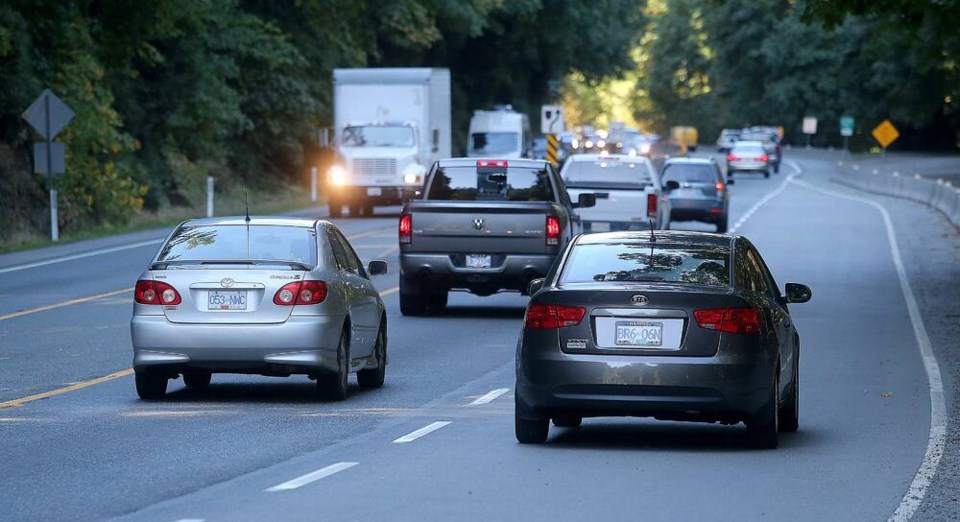Here’s what the provincial government is doing about a long-term fix for the Malahat: Nothing.
That was made clear by a couple of studies that amounted to the province waving a white flag.
First, a 2019 analysis concluded the Malahat isn’t cut off often enough to justify the financial and environmental cost of building an emergency route to be used during long-term closures.
But hold on, we were told, another report was coming out that would — finally! — address the thorny question of how to move half a million people around the region. Alas, when the long-awaited South Island Transportation Strategy finally appeared last year, commuters found it the biggest disappointment since Bobby Orr endorsed Trump.
Instead of a nuts-and-bolts blueprint, it was little more than 29 pages of talk about how it would be nice to add electric-vehicle charging stations, reduce one-occupant cars (great idea, but how?) and walk and cycle more. Fine, but what does that mean for someone trying to get from Saanich to Duncan?
The study used the word “sustainable” 42 times, but “Malahat” just twice, though it did note that a typical Mill Bay-to-Victoria morning commute that took 43 minutes in 2019 would likely take 87 minutes by 2038. It did not explain how that would be “sustainable.”
In the government’s defence, it sees no easy options. And, as the 2019 emergency-route report argues, the Malahat isn’t severed as often as we think. Between 2009 and 2018, the 12.8-kilometre stretch between Shawnigan Lake Road and West Shore Parkway saw 40 closures of half an hour or more. Traffic was cut in both directions for longer than 2.5 hours on just 11 occasions — one big shutdown a year.
The problem is that when it does get shut down, the only real detour is the Victoria-Sooke-Port Renfrew-Lake Cowichan-Duncan route, which is more than 200 kilometres long and isn’t built for heavy traffic. Likewise, the twisting, turning Finlayson Arm Road gets choked faster than a Chretien protester.
And bless the staff who kept the little Brentwood Bay-Mill Bay ferry running all through Monday night, but it only carries 20 cars and takes an hour and 10 minutes per round trip. Do the math: it would take a month of round-the-clock sailings to transport the 25,000 vehicles that drive the Malahat each day.
What are the alternatives to the status quo? That 2019 report examined seven emergency-route options, five of which were quickly deemed too costly, of too little benefit, or posing too great a threat to the region’s drinking water.
That left two, including one that also seemed too far out there, literally and figuratively: a 104-kilometre route that would take traffic west of the watershed and cost $180 million. As CRD chair Colin Plant noted, that’s a lot of money for a once-a-year route that you hope not to use.
That left the most obvious option, beefing up the Niagara Main service road through the Sooke Hills west of the existing highway. The only people who may use it now are those working on the CRD water system.
At 20.3 kilometres and $30 million, it would be the shortest and cheapest of all options — but would trigger an enviro-political struggle that would make Fairy Creek look like a tea party. The Capital Regional District board, the CRD parks committee and the Regional Water Supply Commission were among those warning they would fight any route through the watershed or parks.
The Niagara Main bisects Sooke Hills Regional Park, runs along the edge of Goldstream Provincial Park and skirts the water supply area. Upgrading the road would mean crossing as many as 29 streams, including the fish-bearing Goldstream River. The report mentioned the risk of wildfires.
Other ideas for a Malahat fix? A 2007 engineering study commissioned for the Transportation Ministry shot down 19 alternatives, each of them deemed too loopy, too expensive, or too hard on the environment.
Double-decking the highway through Goldstream Provincial Park was dismissed out of hand. Blowing a bigger hole through the park and expanding the existing route would not only cost hundreds of millions of dollars and leave nature-lovers aghast, it would still leave drivers with no second route.
Although advocates disputed the findings, commuter rail was deemed too expensive, lacking in capacity and of little use to those whose destination is any distance from the tracks.
A bridge — either a four-kilometre, multi-span link between Mill Bay and the northern Saanich Peninsula or a 1.4-kilometre crossing between Bamberton and Highlands — would cost between $700 million and $1.2 billion, and would invite blowback from those worried about the impact on the Pat Bay Highway and the Peninsula.
Meanwhile, the population on both ends of the Malahat rises, and the narrow part of the hourglass gets more congested, more vulnerable.





